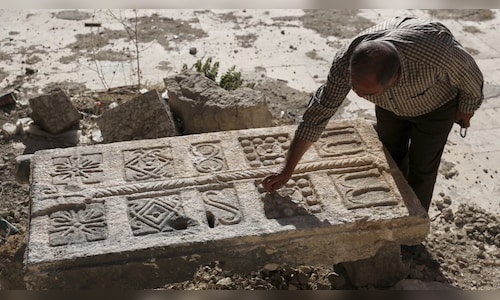This remarkable find was made last month in the town of Maarat al-Numan, located in Idlib province, which plays a crucial role on the route connecting Aleppo and Damascus.
The area has been a focal point in the nearly 14-year Syrian civil war, culminating in the rapid fall of former President Bashar Assad in December.
Assad’s forces regained control of the region from opposition forces in 2020, leading to widespread looting and destruction. Aerial photographs depict many structures still standing but lacking roofs.
Also Read: Israel reports rockets launched from Syria for the first time since Bashar al-Assad’s downfall
Now, as residents begin to return and rebuild, stone openings were found during a reconstruction effort, suggesting the existence of ancient burial sites.
The residents alerted the antiquities directorate, which sent a specialized team to assess and secure the discovery.
Above ground, it appears to be a residential neighborhood lined with cinder-block buildings, many of which bear the marks of war. Next to one such structure, a pit descends to reveal the entries of two burial chambers, housing a total of six stone tombs. The sign of the cross is etched onto the top of one stone column.
“Based on the presence of the cross and the pottery and glass items found, this tomb is from the Byzantine period,” stated Hassan al-Ismail, director of antiquities in Idlib.
He emphasized that this discovery contributes to the already extensive collection of archaeological sites in the region.
Idlib “holds a third of Syria’s monuments, featuring 800 archaeological sites along with an ancient city,” al-Ismail noted.
The Byzantine Empire, which emerged in the 4th century AD, was a continuation of the Roman Empire, with its capital in Constantinople—modern-day Istanbul—and Christianity as its state religion.
Abandoned Byzantine settlements known as Dead Cities dot the rocky hills and plains of northwest Syria, their weathered limestone ruins showcasing remnants of stone houses, basilicas, tombs, and colonnaded streets.
In the past, property owners where archaeological ruins were discovered sometimes opted to conceal them, fearing their land might be taken to protect the ruins, said Ghiath Sheikh Diab, a resident of Maarat al-Numan who witnessed the unearthing of the tomb complex.
Also Read: Turkey supports Syria’s military and has no immediate plans for withdrawal, says defense minister
He expressed hope that the new government would compensate property owners fairly in such instances and offer support to displaced individuals returning to find their homes in ruins.
The prolonged conflict has caused severe damage to Syria’s archaeological sites, not only through bombings but also looting and unauthorized excavations.
Some view these ruins as a beacon of hope for economic revival.
Another local resident, Abed Jaafar, visited the newly discovered tombs with his son to explore and take photographs.
“In the past, many international tourists came to Maarat solely to see the ruins,” he remarked. “We need to preserve and restore the antiquities to their former state … as this will help revive tourism and bolster the economy.”



